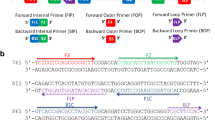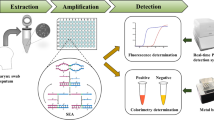Abstract
Methods for the early and sensitive detection of pathogenic bacteria suited to low-resource settings could impact diagnosis and management of diseases. Helicase-dependent isothermal amplification (HDA) is an ideal tool for this purpose, especially when combined with a sequence-specific detection method able to improve the selectivity of the assay. The implementation of this approach requires that its analytical performance is shown to be comparable with the gold standard method, polymerase chain reaction (PCR). In this study, we optimize and compare the asymmetric amplification of an 84-base-long DNA sequence specific for Mycobacterium tuberculosis by PCR and HDA, using an electrochemical genomagnetic assay for hybridization-based detection of the obtained single-stranded amplicons. The results indicate the generalizability of the magnetic platform with electrochemical detection for quantifying amplification products without previous purification. Moreover, we demonstrate that under optimal conditions the same gene can be amplified by either PCR or HDA, allowing the detection of as low as 30 copies of the target gene sequence with acceptable reproducibility. Both assays have been applied to the detection of M. tuberculosis in sputum, urine, and pleural fluid samples with comparable results. Simplicity and isothermal nature of HDA offer great potential for the development of point-of-care devices.

Comparative evaluation of isothermal helicase-dependent amplification and PCR for electrochemical detection of Mycobacterium tuberculosis





Similar content being viewed by others
References
World Health Organization. Global tuberculosis report 2015 (http://apps.who.int/iris/bitstream/10665/191102/1/9789241565059_eng.pdf). Last accessed 15 February 2016.
Dheda K, Ruhwald M, Theron G, Peter J, Yam WC. Respirology. 2013;18:217–32.
Wilson ML. Clin Infect Dis. 2011;52:1350–5.
Piersimoni C, Scarparo C. J Clin Microbiol. 2003;41:5355–65.
Ioannidis P, Papaventsis D, Karabela S, Nikolaou S, Panagi M, Raftopoulou E, et al. J Clin Microbiol. 2011;49:3068–70.
Asiello PJ, Baeumner AJ. Lab Chip. 2011;11:1420–30.
Niemz A, Ferguson TM, Boyle DS. Trends Biotechnol. 2011;29:240–50.
Li J, Macdonald J. Biosens Bioelectron. 2015;64:196–211.
Zhao Y, Chen F, Li Q, Wang L, Fan C. Chem Rev. 2015;115:12491–545.
Aryan E, Makvandi M, Farajzadeh A, Huygen K, Bifani P, Mousavi S-L, et al. Microbiol Res. 2010;165:211–20.
Manage DP, Chui L, Pilarski L. Microfluid Nanofluid. 2013;14:731–41.
Roskos K, Hickerson AI, Lu H-W, Ferguson TM, Shinde DN, Klaue Y, et al. PLoS One. 2013;8, e69355.
Boyle DS, McNerney R, Low HT, Leader BT, Pérez-Osorio AC, Meyer JC, et al. PLoS One. 2014;9:e103091.
Ng BYC, Xiao W, West NP, Wee EJH, Wang Y, Trau M. Anal Chem. 2015;87:10613–8.
Ng BYC, Wee EJH, West NP, Trau M. Sci Rep. 2015;5:15027.
Shin Y, Perera AP, Tang WY, Fu DL, Liu Q, Sheng JK, et al. Biosens Bioelectron. 2015;68:30–396.
Ng BYC, Wee EJH, West NP, Trau M (2015) ACS sens DOI: 10.1021/acssensors.5b00171
Motré A, Kong R, Li Y. J Microbiol Meth. 2011;84:343–5.
Torres-Chavolla E, Alocilja E. Biosens Bioelectron. 2011;26:4614–8.
Ao W, Aldous S, Woodruff E, Hicke B, Rea L, Kreiswirth B, et al. J Clin Microbiol. 2012;50:2433–40.
Barreda-García S, González-Álvarez MJ, de-los-Santos-Álvarez N, Palacios-Gutiérrez JJ, Miranda-Ordieres AJ, Lobo-Castañón MJ. Biosens Bioelectron. 2015;68:122–8.
Notomi T, Okayama H, Masubuchi H, Yonekawa T, Watanabe K, Amino N, et al. Nucleic Acids Res. 2000;28:e63.
Vincent M, Xu Y, Kong H. EMBO Rep. 2004;5:795–800.
Poepenburg O, Williams C, Stemple DL, Armes NA. PLoS Biol. 2006;4:1115–21.
Patterson AS, Hsieh K, Soh HT, Plaxco KW. Trends Biotech. 2013;31:704–12.
Moura-Melo S, Miranda-Castro R, de-los-Santos Álvarez N, Miranda-Ordieres AJ, Ribeiro J, Fonseca R, et al. Anal Chem. 2015;87:8547–54.
Untergasser A, Cutcutache I, Koressaar T, Ye J, Faircloth BC, Remm M, et al. Nucleic Acid Res. 2012;40:e115.
Ye J, Coulouris G, Zaretskaya I, Cutcutache I, Rozen S, Madden T. BMC Bioinformatics. 2012;13:134.
Zuker M. Nucleic Acid Res. 2003;31:3406–15.
Jezewska MJ, Lucius AL, Bujalowski W. Biochem. 2005;44:3877–90.
Acknowledgments
This research has been supported by the Spanish Ministerio de Economía y Competitividad (project CTQ2012-31157), the European Regional Development Fund, and Principado de Asturias government (FC-15-GRUPIN14-025). RMC thanks Principado de Asturias government and FICYT for a Clarín post-doctoral contract. We thank Dr. Juan José Palacios-Gutiérrez from Hospital Universitario de Asturias for providing the clinical samples.
Author information
Authors and Affiliations
Corresponding author
Ethics declarations
Conflict of interest
The authors declare that they have no conflict of interest
Additional information
Published in the topical collection Isothermal Nucleic Acid Amplification in Bioanalysis with guest editor Maria Jesus Lobo Castañón.
Rights and permissions
About this article
Cite this article
Barreda-García, S., Miranda-Castro, R., de-los-Santos-Álvarez, N. et al. Comparison of isothermal helicase-dependent amplification and PCR for the detection of Mycobacterium tuberculosis by an electrochemical genomagnetic assay. Anal Bioanal Chem 408, 8603–8610 (2016). https://doi.org/10.1007/s00216-016-9514-z
Received:
Revised:
Accepted:
Published:
Issue Date:
DOI: https://doi.org/10.1007/s00216-016-9514-z




